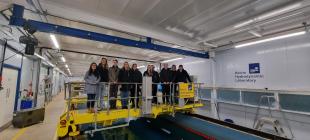Kelvin Hydrodynamics Laboratory
Kelvin Hydrodynamics Laboratory is the second largest hydrodynamic test tank in the UK. The tank provides excellent conditions for measuring performance of surface ships and a wide variety of floating and underwater structures. Ship models used are typically up to 4m in length. High-quality single-frequency waves and random sea-states may be generated with wave heights well over 0.5m. Motions of floating vessels and structures are measured using a state-of-the-art real-time non-contact infrared camera system.
Resistance dynamometers for different vessel types and model sizes are available as well as a six degree-of-freedom dynamometer for force measurement. Up to 25 wave probes may be used to determine water surface elevation in the tank. A 3-axis fluid velocity measurement system is also available, and a PIV system is currently being installed. Pressure distributions on model surfaces can be measured. Above-water and underwater video systems are available.
The tank is commonly used for a wide range of marine hydrodynamics tests including measurement of: ship resistance and sea-keeping; unsteady motion of ships and floating bodies; survivability of damaged ships; hydrodynamics of towed surface-piercing and submerged bodies; ocean engineering studies including vortex-induced vibration and vortex-induced motion; wave impact and slamming studies; marine renewable energy studies including device performance, maintainability and survivability; sporting fluid dynamics.







